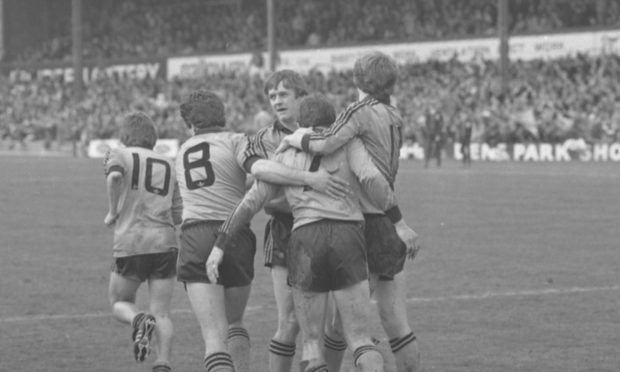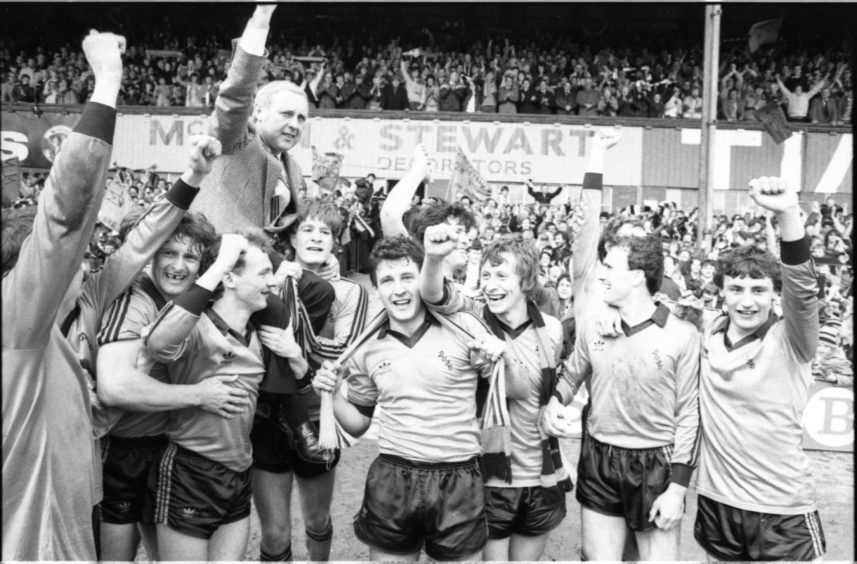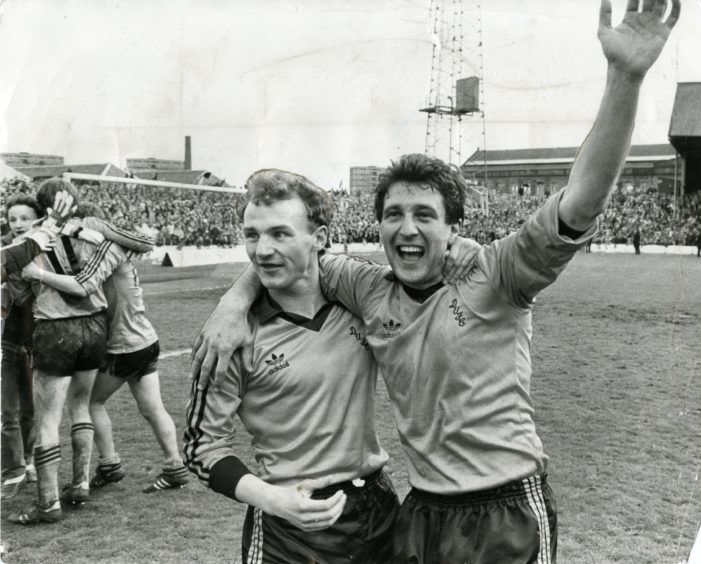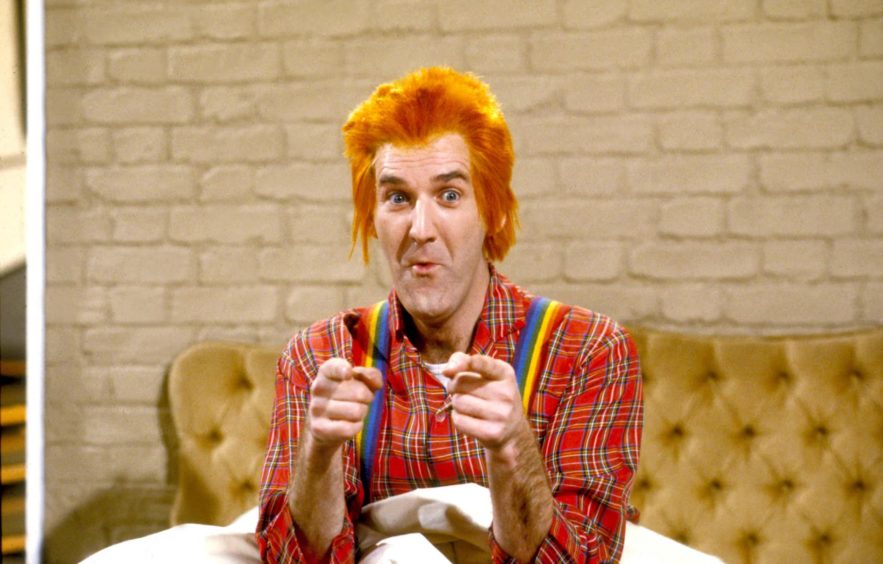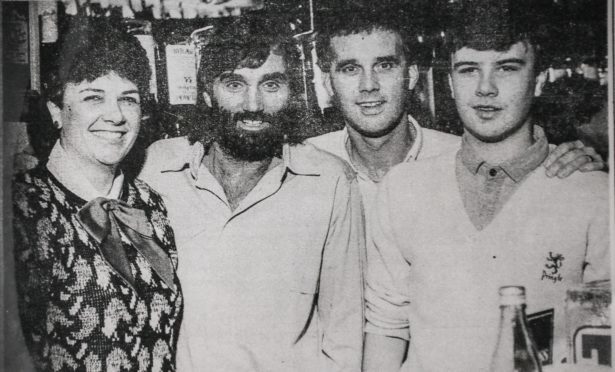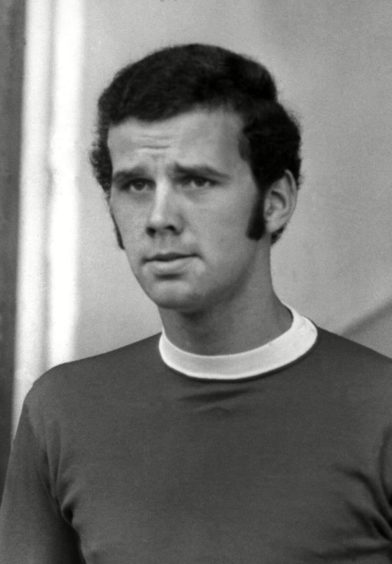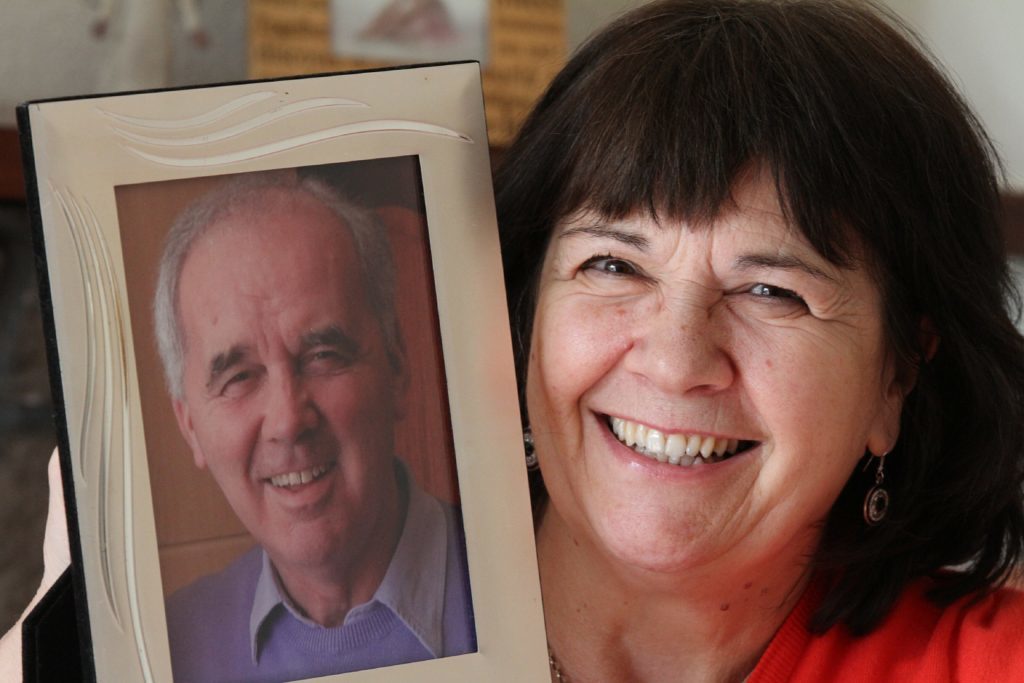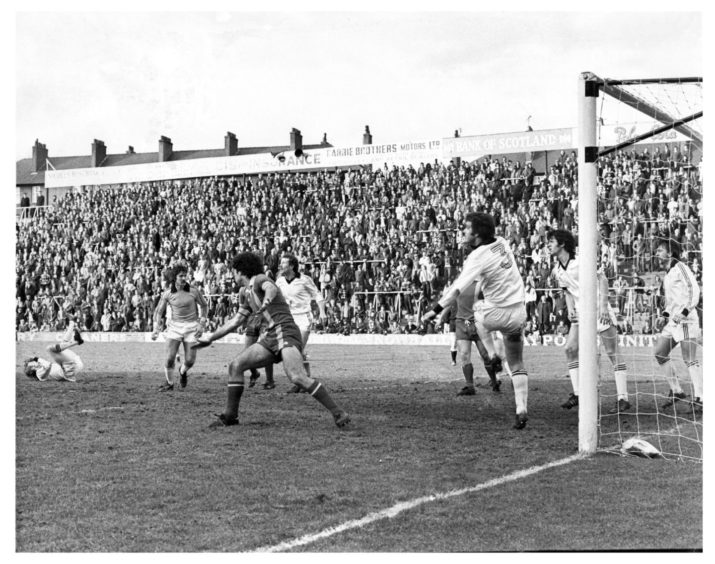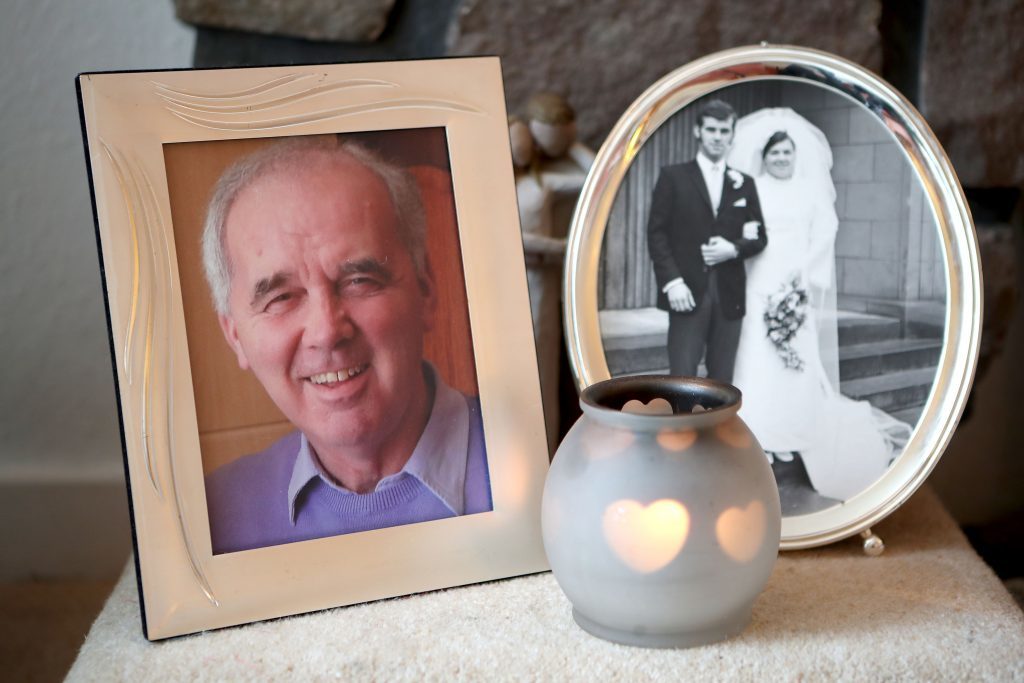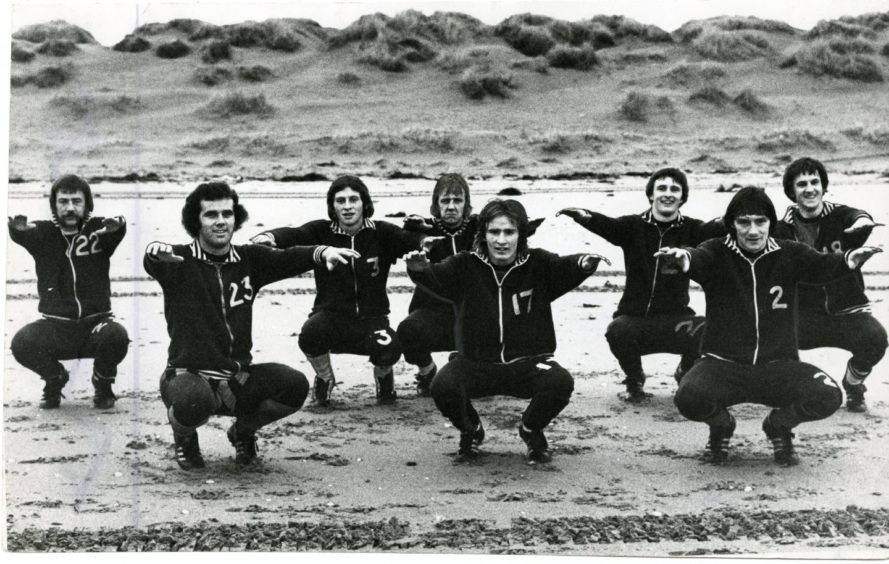Dundee United’s historic league winning celebrations brought the house down in Monifieth in 1983.
Frank Kopel and his wife Amanda hosted the party which took place after Jim McLean’s side won their solitary Premier League championship title with victory against Dundee at Dens Park.
The couple were moving home the following day to live in Kirriemuir and take over the Roods Bar.
Mine host
But first they would host an impromptu party with just a few days notice to celebrate the biggest day in the club’s history.
Frank spent 10 years at Tannadice and made 407 appearances before he left the club in 1982 to join Arbroath.
“There were 78 people in our three-bedroom bungalow in Monifieth that night,” recalled Amanda.
“That was on the Saturday and on the Sunday we were moving up to Kirrie because we had bought the pub.
“Everything was in cardboard boxes except for the furniture.
“Paul Sturrock was supposed to have the party but he pulled out of hosting it.
“I always remember Frank coming into the bank where I worked to tell me and I said: ‘Oh that’s a shame, so where are you going to celebrate if the boys win on Saturday?’
“He said: ‘I just told them to come to our house’.
“Frank gave me 48 hours notice.
“The glasses and plates were all in boxes but we borrowed them from neighbours.
“My sister Joy and my brother-in-law Colin were coming down that weekend to help us move house.
“They stood in the kitchen all night washing dishes and glasses!”
Russ Abbot
United won the league at Dens and Amanda recalled it was the perfect going away party.
“There was a couch, two seats and six dining room chairs between 78 people,” she said.
“Everyone either sat on them or on the floor or they stood in the hall way or the kitchen or wherever there was space among the boxes.
“I remember Davie Dodds turned up at the door wearing a traffic cone on his head!
“One of the highlights was Hamish McAlpine dressing up as the ‘See You Jimmy’ character from the Russ Abbot Show.
“He wore a tartan hat, a kilt and a white t-shirt complete with braces and I remember I had to spray his hair tangerine!
“I then had to announce during the party that we were being joined by a special guest and Hamish walked in speaking just like the character.
“Everyone was in fits of laughter.”
Jim McLean
The door bell kept ringing all night with first-team players, reserves, directors, neighbours, family and friends.
One person who was missing though was manager Jim McLean and Amanda called him up to invite him over.
McLean turned the offer down though and said he didn’t want to spoil the lads’ night!
“It was a lovely going away party which left us with so many happy memories,” she said.
“We spent three years at the Roods and the most famous night was in 1984 when George Best came to do our Christmas raffle in the pub.
“Frank and George were team-mates at Manchester United and he pulled out his own ticket by chance which was for a gallon bottle of whisky.
“Being the gentleman that he was, George put the ticket back in his pocket, picked out another one, and one lucky customer went home that night with the bottle instead.”
Lake District
Frank returned to United for short spells to help out with the reserves.
Amanda said: “Jim kept on his registration as a player and I remember we had gone away to the Lake District for the weekend.
“Frank got a phone call to ask him to play in the reserves the following night at Clydebank because Jim was short of players.
“I told him to tell Jim we were away for a short break but he replied: ‘I can’t let the boss down’.
“We immediately packed up and came all the way back up to Scotland.
“It was a very silent car journey.
“I sat there in the stand and watched him play on a miserable night.
“But Frank loved United and would do anything for Jim.”
Childhood sweethearts
Amanda and Frank met each other when they were eight and 10, living across the road from each other in Falkirk.
They went to different schools but got together at a party during a game of Postman’s Knock.
Frank signed for Manchester United as a 16-year-old schoolboy and played for Matt Busby alongside the Holy Trinity of George Best, Denis Law and Bobby Charlton.
After three years at the club, Frank played a further three seasons in England, for Blackburn Rovers, before transferring to Dundee United in 1972.
Frank’s return to Scotland came after a phone call from Jim McLean on Hogmanay 1971.
The couple packed a few things and drove to Scotland where they stopped at Amanda’s parents house in Falkirk to bring in the New Year.
The following day they went to Muirton Park where United were playing St Johnstone and Frank became McLean’s first-ever signing.
He lifted the League Cup twice during a decade at Tannadice which included scoring a famous goal against Anderlecht in the UEFA Cup in 1979.
He became a fans’ favourite and even had a supporters’ group named after him: Frank Kopel’s Travelling Shindig.
Frank moved to Arbroath as a player/coach in 1982, finally hanging up his boots in 1984.
He went on to coach Forfar Athletic, working with former Dundee United players Henry Hall and Paul Hegarty in the 1990s.
Tragic diagnosis
But just a decade later he was struggling to remember his past glories on the football pitch.
Amanda first suspected something was wrong when he told her he felt as if he was walking in a fog and his tragic diagnosis at the age of 59 would bring football’s dementia problem into focus.
She said: “At the hall of fame dinner in 2011 when Frank was inducted I remember he was struggling with his speech that night.
“Our lives were changed forever when he was given the news.
“The day we got the diagnosis I knew it was the end of our world.”
Amanda was with him every step of the way before he passed away aged 65 in April 2014 at his home in Kirriemuir.
The family faced the distress of feeling unable to get the correct diagnosis of Frank’s condition until having his medical history re-examined by neuropathologist Dr Willie Stewart.
Frank, who headed rain-sodden, heavy-leather footballs in the 1960s and 70s, was the first confirmed case of Chronic Traumatic Encephalopathy (CTE) in Scottish football – something more commonly associated with boxers.
Amanda led the victorious Frank’s Law campaign following her husband’s death.
The campaign, backed by The Courier, came into force in April 2019 to abolish care charges for under-65s with debilitating conditions.
Fighting spirit
Amanda’s campaigning spirit has continued to protect the current generation of footballers.
She said: “Dementia has no respect for age, creed, colour or gender when it strikes, as we found out… and it doesn’t take sides.
“There is, sadly only one winner – that evil disease – and one loser, which is our men.
“Every time I pick up a newspaper there is another player from Frank’s playing days who is suffering from dementia.”
The news that Frank’s former team-mate Sir Bobby Charlton has been diagnosed with dementia has prompted fresh debate over what can be done.
Sir Bobby’s brother Jack, Ray Wilson, Martin Peters and Nobby Stiles from the England 1966 World Cup squad have all died over the last two-and-a-half years.
North of the border Lisbon Lions Billy McNeill and Stevie Chalmers were among the high-profile ex-players to succumb to it.
The Scottish Football Association took measures to protect the next generation by banning children under 12 from heading the ball in games.
“Frank would stay behind after playing to practice his heading from a young age,” said Amanda.
“If you told him then that the headers might lead to this horrible disease in later life, he would have done it anyway because he was fanatical about football.
“Children are not able to make informed decisions and need to be protected.
“He would have benefited if the authorities had stepped in to tell him that they wouldn’t be heading balls until a certain age.”
Too late
Unfortunately, it is too late for the likes of Frank, Nobby Stiles, Malcolm Allison and countless others.
Amanda said: “I always remember speaking to Frank about the Frank’s Law campaign.
“I told him it was a battle we were going to win.
“He just looked at me and said: ‘But I’m not going to win my battle’.
“I said: ‘You never know, there might just be a cure…’
“Even up to the day Frank died in my arms I was hoping the phone would ring.
“I wouldn’t wish that disease on my worst enemy.”
